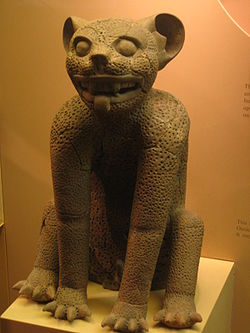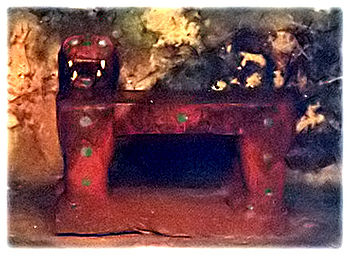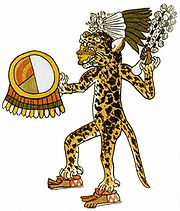
Jaguars in Mesoamerican culture
Encyclopedia

Mesoamerican chronology
Mesoamerican chronology divides the history of pre-Columbian Mesoamerica into several periods: the Paleo-Indian , the Archaic , the Preclassic , the Classic , and the Postclassic...
. The jaguar
Jaguar
The jaguar is a big cat, a feline in the Panthera genus, and is the only Panthera species found in the Americas. The jaguar is the third-largest feline after the tiger and the lion, and the largest in the Western Hemisphere. The jaguar's present range extends from Southern United States and Mexico...
(Panthera onca) is an animal with a prominent association and appearance in the cultures and belief systems of pre-Columbian
Pre-Columbian
The pre-Columbian era incorporates all period subdivisions in the history and prehistory of the Americas before the appearance of significant European influences on the American continents, spanning the time of the original settlement in the Upper Paleolithic period to European colonization during...
Mesoamerica
Mesoamerica
Mesoamerica is a region and culture area in the Americas, extending approximately from central Mexico to Belize, Guatemala, El Salvador, Honduras, Nicaragua, and Costa Rica, within which a number of pre-Columbian societies flourished before the Spanish colonization of the Americas in the 15th and...
n societies. Quick, agile, and powerful enough to take down the largest prey in the jungle, the jaguar is the largest of the big cat
Big cat
The term big cat – which is not a biological classification – is used informally to distinguish the larger felid species from smaller ones. One definition of "big cat" includes the four members of the genus Panthera: the tiger, lion, jaguar, and leopard. Members of this genus are the only cats able...
s in the Americas
Americas
The Americas, or America , are lands in the Western hemisphere, also known as the New World. In English, the plural form the Americas is often used to refer to the landmasses of North America and South America with their associated islands and regions, while the singular form America is primarily...
, and one of the most efficient and aggressive predators. Endowed with a spotted coat and well adapted for the jungle, hunting either in the trees or water, making it one of the few felines tolerant of water, the jaguar was, and remains, revered among the indigenous Americans
Indigenous peoples of the Americas
The indigenous peoples of the Americas are the pre-Columbian inhabitants of North and South America, their descendants and other ethnic groups who are identified with those peoples. Indigenous peoples are known in Canada as Aboriginal peoples, and in the United States as Native Americans...
who live closely with the jaguar.
All major Mesoamerican civilizations prominently featured a jaguar god, and for many, such as the Olmec
Olmec
The Olmec were the first major Pre-Columbian civilization in Mexico. They lived in the tropical lowlands of south-central Mexico, in the modern-day states of Veracruz and Tabasco....
, the jaguar was an important part of shamanism (Miller & Taube, p. 103).
Olmecs, jaguars, and the "were-jaguar"
The Olmec civilization was first defined as a distinctive art style at the turn of the nineteenth century. The various sculpture, figurines, and celtsCelt (tool)
Celt is an archaeological term used to describe long thin prehistoric stone or bronze adzes, other axe-like tools, and hoes.-Etymology:The term "celt" came about from what was very probably a copyist's error in many medieval manuscript copies of Job 19:24 in the Latin Vulgate Bible, which became...
from what now is recognized as the Olmec heartland
Olmec heartland
The Olmec heartland is the southern portion of Mexico's Gulf Coast region between the Tuxtla mountains and the Olmec archaeological site of La Venta, extending roughly 80 km inland from the Gulf of Mexico coastline at its deepest...
on the southern Gulf
Gulf of Mexico
The Gulf of Mexico is a partially landlocked ocean basin largely surrounded by the North American continent and the island of Cuba. It is bounded on the northeast, north and northwest by the Gulf Coast of the United States, on the southwest and south by Mexico, and on the southeast by Cuba. In...
Coast, reveal that these people knew their jungle companions well and incorporated them into their mythology.
In the surviving Olmec archaeological record
Archaeological record
The archaeological record is the body of physical evidence about the past. It is one of the most basic concepts in archaeology, the academic discipline concerned with documenting and interpreting the archaeological record....
, jaguars are rarely portrayed naturalistically, but rather with a combination of feline and human characteristics. These feline anthropomorphic figures may range from a human figure with slight jaguar characteristics to depictions of shamanistic transformations in the so-called transformative pose, kneeling with hands on knees, to figures that are nearly completely feline.
One of the most prominent, distinctive, and enigmatic Olmec designs to appear in the archaeological record has been the "were
Were
Were and wer are archaic terms for adult male humans and were often used for alliteration with wife as "were and wife" in Germanic-speaking cultures ....
-jaguar". Seen not only in figurines, the motif also may be found carved into jade
Jade use in Mesoamerica
Jade use in Mesoamerica was largely influenced by the conceptualization of the material as a rare and valued commodity among pre-Columbian Mesoamerican cultures, such as the Olmec, the Maya, and the various groups in the Valley of Mexico. The only source from which the indigenous cultures could...
“votive axes” and celts, engraved onto various portable figurines of jade, and depicted on several "altars", such as those at La Venta
La Venta
La Venta is a pre-Columbian archaeological site of the Olmec civilization located in the present-day Mexican state of Tabasco. Some of the artifacts have been moved to the museum "Parque - Museo de La Venta", which is in Villahermosa, the capital of Tabasco....
. Were-jaguar babies are often held by a stoic, seated adult male.
.jpg)
It is not known what the were-jaguar represented to the Olmec, and it may well have represented different things at different times.
Jaguars and shamans
The jaguar also is important for shamans who often associate the jaguar as a spirit companion or nagual, which will protect the shamans from evil spirits and while they move between the earth and the spirit realm. In order for the shamans to combat whatever evil forces may be threatening, or for those who rely on the shamans for protection, it is necessary for the shamans to transform and cross over to the spirit realm. The jaguar is often as a nagual because of its strength, for it is necessary that the shamans "dominate the spirits, in the same way as a predator dominates its prey" (Saunders 1998:30). The jaguar is said to possess the transient ability of moving between worlds because of its comfort both in the trees and the water, the ability to hunt as well in the nighttime as in the daytime, and the habit of sleeping in caves, places often associated with the deceased ancestors. The concept of the transformation of the shaman is well documented in Mesoamerica and South America and is in particular demonstrated in the various Olmec jaguar transformation figures (Diehl, p. 106).Jaguars and the Maya

Yucatán Peninsula
The Yucatán Peninsula, in southeastern Mexico, separates the Caribbean Sea from the Gulf of Mexico, with the northern coastline on the Yucatán Channel...
all the way to the Pacific coast of Guatemala
Guatemala
Guatemala is a country in Central America bordered by Mexico to the north and west, the Pacific Ocean to the southwest, Belize to the northeast, the Caribbean to the east, and Honduras and El Salvador to the southeast...
, was a literate society who left documentation of their lives (mostly the lives of the aristocracy) and belief system in the form of bas-relief sculpture on temples, stelae, and pottery. Often depicted on these artifacts are the gods the Maya revered and it is no coincidence that these gods often have jaguar attributes. As stated earlier, the jaguar is said to have the ability to cross between worlds, and for the Maya daytime and nighttime represented two different worlds. The living and the earth are associated with the day, and the spirit world and the ancestors are associated with the night. As the jaguar is quite at home in the nighttime, the jaguar is believed to part of the underworld; thus, "Maya gods with jaguar attributes or garments are underworld gods" (Benson 1998:64). One such god is Xbalanque, one of the Maya Hero Twins
Maya Hero Twins
The Maya Hero Twins are the central figures of a narrative included within the colonial Quiché document called Popol Vuh, and constituting the oldest Maya myth to have been preserved in its entirety. Called Hunahpu and Xbalanque in Quiché, the Twins have also been identified in the art of the...
who descended to the underworld, and whose entire body is covered with patches of jaguar skin. Another is God L
God L
God L of the Schellhas-Zimmermann-Taube classification of codical gods is one of the major pre-Spanish Maya deities, specifically associated with trade. He is characterized by high age, jaguar traits , a broad feathery hat topped by an owl, and by a jaguar mantle or a cape with a pattern somewhat...
, who is "the primary lord of the underworld" and often is shown with a jaguar ear or jaguar attire, and atop a jaguar throne (Benson 1998: 64-65). Not only is the underworld associated with the ancestors, but it also is understood as, where plants originate. In addition, the Maya's source of fresh water comes from underground pools in the porous limestone that makes up the Yucatán, called cenotes. These associations with water and plants further reinforce the notion of the jaguar as a god of fertility
Fertility
Fertility is the natural capability of producing offsprings. As a measure, "fertility rate" is the number of children born per couple, person or population. Fertility differs from fecundity, which is defined as the potential for reproduction...
.
The jaguar is further associated with vegetation
Vegetation
Vegetation is a general term for the plant life of a region; it refers to the ground cover provided by plants. It is a general term, without specific reference to particular taxa, life forms, structure, spatial extent, or any other specific botanical or geographic characteristics. It is broader...
and fertility by the Maya with what is known as the Waterlily jaguar, which is depicted as having water lilies sprouting from its head (Benson 1998:64-67).
No doubt, the jaguar's brilliant coat made it quite desirable, however, not all were allowed to don the jaguar pelt as it became the identification of the ruling class for the Maya. Not only did Maya kings wear jaguar pelts, but they also adopted the jaguar as part of their ruling name, as a symbol of their might and authority. One such ruling family to incorporate the jaguar into their name is known as, Jaguar Paw, who ruled the Maya city of Tikal
Tikal
Tikal is one of the largest archaeological sites and urban centres of the pre-Columbian Maya civilization. It is located in the archaeological region of the Petén Basin in what is now northern Guatemala...
in the fourth century. Jaguar Paw I was ousted by central Mexicans from Teotihuacán
Teotihuacán
Teotihuacan – also written Teotihuacán, with a Spanish orthographic accent on the last syllable – is an enormous archaeological site in the Basin of Mexico, just 30 miles northeast of Mexico City, containing some of the largest pyramidal structures built in the pre-Columbian Americas...
, and it was not until late in the fifth century that the Jaguar Paw family returned to power (Coe 1999: 90). Other Maya rulers to incorporate the jaguar name include, Scroll Jaguar, Bird Jaguar, and Moon Jaguar, just to name a few (Coe 1999: 247-48). In addition to the ruling class, the jaguar also was associated with warriors and hunters. Those who excelled in hunting and warfare often adorned themselves with jaguar pelts, teeth, or claws and were "regarded as possessing feline souls" (Saunders 1998: 26).

Tehuantepec
Tehuantl (variously rendered) means "jaguar" in NahuatlNahuatl
Nahuatl is thought to mean "a good, clear sound" This language name has several spellings, among them náhuatl , Naoatl, Nauatl, Nahuatl, Nawatl. In a back formation from the name of the language, the ethnic group of Nahuatl speakers are called Nahua...
while tepec means "hill". The name refers to a particular hill in southern Mexico which is believed to have been an important shrine in the jaguar cult throughout several eras of Mesoamerican history. Subsequently, the name also was applied to the isthmus in southern Mexico
Isthmus of Tehuantepec
The Isthmus of Tehuantepec is an isthmus in Mexico. It represents the shortest distance between the Gulf of Mexico and the Pacific Ocean, and prior to the opening of the Panama Canal was a major shipping route known simply as the Tehuantepec Route...
upon which the hill lies, as well as to the gulf on the Pacific shore
Gulf of Tehuantepec
Gulf of Tehuantepec is a large body of water on the Pacific coast of the Isthmus of Tehuantepec, southeastern Mexico, at . Most of the hurricanes that form in the Eastern Pacific organize in or near this body of water...
of the isthmus.
Summary
For those who resided in or near the tropical jungle, the jaguar was well known and became incorporated into the lives of the inhabitants. The jaguar's formidable size, reputation as a predator, and its evolved capacities to survive in the jungle made it an animal to be revered. The Olmec and the Maya witnessed this advanced animal, adopting the jaguar as an authoritative and martial symbol, and incorporated this magnificent beast into their mythology. The jaguar stands today, as it did in the past, as an important symbol for the sacred and profaneSacred and Profane
Sacred and Profane is a 1987 novel by Faye Kellerman. It is second in the Peter Decker/Rina Lazarus series.A Fawcett Crest Book published by Ballantine Books.Timeline: About six months after The Ritual Bath, starts Christmas Eve, Decker is 39....
lives of those who coexist with this majestic feline.

